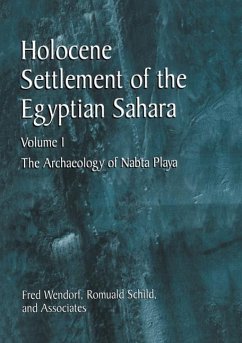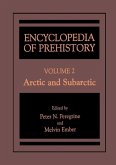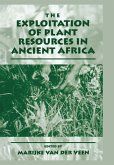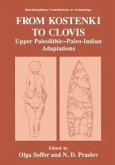by Fred Wendorf and Romuald Schild The Eastern Sahara is a fascinating place to study structures. These larger, more complex sites are almost prehistory. Confronted with the stark reality of a hyper always in the lower parts of large basins, most of which arid environment that receives no measurable rainfall, were formed by deflation during the Late Pleistocene lacks vegetation, and is seemingly without life, it would hyper-arid interval between about 65,000 and 13,000 seem to be an unlikely place to find a rich and complex years ago. Their location near the floor of these basins mosaic of archaeological remains documenting past was influenced primarily by one factor - water. During human presence. Despite this impression of a hostile wet phases, runoff from extensive catchment areas environment, there is widespread and abundant caused the development of large, deep, seasonal lakes, archaeological evidence. or playas, in the lowermost parts of these basins. This It is obvious that this area was not always a lifeless surface water would last for several weeks or months desert. Faunal and plant remains found in the excavations after the seasonal rains, and by digging wells after the at Holocene-age settlements, dating between 9500 and playa became dry, water could still be obtained during 5000 radiocarbon years ago, indicate that rainfall during most, if not all, of the dry season.
Dieser Download kann aus rechtlichen Gründen nur mit Rechnungsadresse in A, B, BG, CY, CZ, D, DK, EW, E, FIN, F, GR, HR, H, IRL, I, LT, L, LR, M, NL, PL, P, R, S, SLO, SK ausgeliefert werden.
'The Archaeology of Nabta Playa is truly an opus magnus; it is not a casual read, and it will be cited for years to come. As a valuable reference work written for interested experts, it will be of most interest to those who share similar regional and topical foci. This book is thorougly and unequivocally recommended for students of African prehistory... In terms of value for money, however, this work speaks volumes.' -- The Holocene, 13:2 (2003)
'[...] it is important to stress the objective contribution that these volumes make to the prehistory of the eastern Sahara. They are extremely well produced, with ample illustrations and statistics, and no detail is spared in the description of habitation sites and small finds. Volumes 1 and 2 of Nabta Playa are a superb addition to the prehistory of the eastern Sahara.' -- Antiquity, 77:297 (September 2003)
'[...] contains a marvelous range of information on many aspects of life in the Holocene of the eastern Sahara. The publication is of a very high standard - well finishes and proofread - and should grace the shelves of Saharanists, as well as any university library where African history is taught.' -- Journal of Anthropological Research, 59 (2003)
"It is clear that this book is a milestone. Wendorf and his team are to be enthusistically congratulated for contributing to the renewal of some critical theoretical and historical problems, and for their exemplary multidisciplinary research strategy." (Savino di Lernia; African Archaeological Review, 21:1)
'[...] it is important to stress the objective contribution that these volumes make to the prehistory of the eastern Sahara. They are extremely well produced, with ample illustrations and statistics, and no detail is spared in the description of habitation sites and small finds. Volumes 1 and 2 of Nabta Playa are a superb addition to the prehistory of the eastern Sahara.' -- Antiquity, 77:297 (September 2003)
'[...] contains a marvelous range of information on many aspects of life in the Holocene of the eastern Sahara. The publication is of a very high standard - well finishes and proofread - and should grace the shelves of Saharanists, as well as any university library where African history is taught.' -- Journal of Anthropological Research, 59 (2003)
"It is clear that this book is a milestone. Wendorf and his team are to be enthusistically congratulated for contributing to the renewal of some critical theoretical and historical problems, and for their exemplary multidisciplinary research strategy." (Savino di Lernia; African Archaeological Review, 21:1)
`The Archaeology of Nabta Playa is truly an opus magnus; it is not a casual read, and it will be cited for years to come. As a valuable reference work written for interested experts, it will be of most interest to those who share similar regional and topical foci. This book is thorougly and unequivocally recommended for students of African prehistory... In terms of value for money, however, this work speaks volumes.'
The Holocene, 13:2 (2003)
`[...] it is important to stress the objective contribution that these volumes make to the prehistory of the eastern Sahara. They are extremely well produced, with ample illustrations and statistics, and no detail is spared in the description of habitation sites and small finds. Volumes 1 and 2 of Nabta Playa are a superb addition to the prehistory of the eastern Sahara.'
Antiquity, 77:297 (September 2003)
`[...] contains a marvelous range of information on many aspects of life in the Holocene of the eastern Sahara. The publication is of a very high standard - well finishes and proofread - and should grace the shelves of Saharanists, as well as any university library where African history is taught.'
Journal of Anthropological Research, 59 (2003)
"It is clear that this book is a milestone. Wendorf and his team are to be enthusistically congratulated for contributing to the renewal of some critical theoretical and historical problems, and for their exemplary multidisciplinary research strategy." (Savino di Lernia; African Archaeological Review, 21:1)
The Holocene, 13:2 (2003)
`[...] it is important to stress the objective contribution that these volumes make to the prehistory of the eastern Sahara. They are extremely well produced, with ample illustrations and statistics, and no detail is spared in the description of habitation sites and small finds. Volumes 1 and 2 of Nabta Playa are a superb addition to the prehistory of the eastern Sahara.'
Antiquity, 77:297 (September 2003)
`[...] contains a marvelous range of information on many aspects of life in the Holocene of the eastern Sahara. The publication is of a very high standard - well finishes and proofread - and should grace the shelves of Saharanists, as well as any university library where African history is taught.'
Journal of Anthropological Research, 59 (2003)
"It is clear that this book is a milestone. Wendorf and his team are to be enthusistically congratulated for contributing to the renewal of some critical theoretical and historical problems, and for their exemplary multidisciplinary research strategy." (Savino di Lernia; African Archaeological Review, 21:1)









